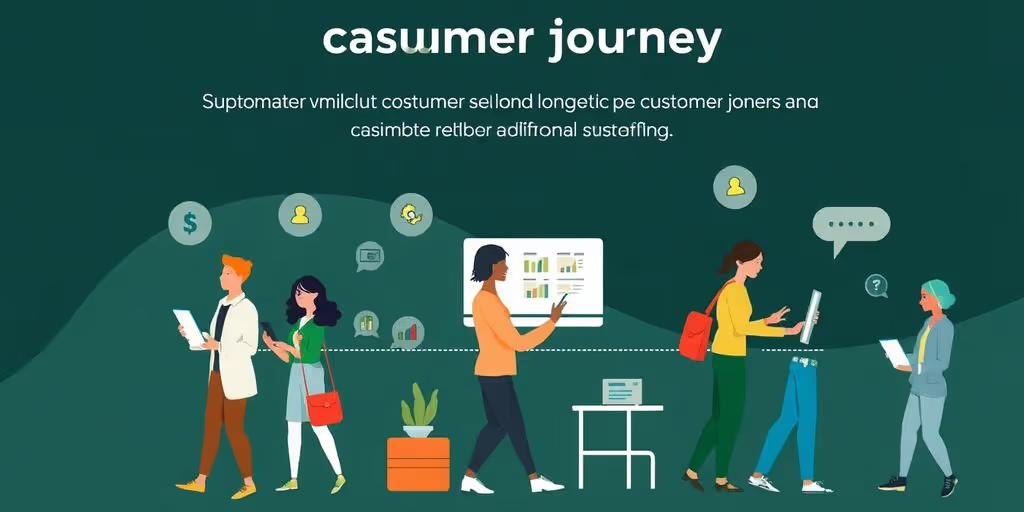"Customer Journey Automation: Creating Personalized Experiences Without Adding Staff"
Explore how artificial intelligence automates customer journeys for personalized experiences without extra staff.
In today's fast-paced business world, companies are constantly looking for ways to improve customer experiences without expanding their workforce. One effective solution is customer journey automation, which utilizes artificial intelligence to create tailored interactions. By automating processes and leveraging data, businesses can enhance customer satisfaction while keeping operational costs in check. This article explores how to harness AI for personalized customer journeys and what it means for the future of customer service.
Key Takeaways
- Artificial intelligence helps businesses understand customer behavior better.
- Automating interactions can save time and reduce the need for additional staff.
- Personalized experiences are crucial for customer retention and satisfaction.
- Integrating AI into existing systems can streamline operations and enhance data security.
- Measuring the success of AI initiatives is essential for ongoing improvement.
Leveraging Artificial Intelligence For Customer Insights
AI is changing how businesses understand their customers. It's not just about collecting data anymore; it's about making sense of it in a way that drives better experiences and, ultimately, more sales. Let's look at how AI helps in this area.
Understanding Customer Behavior
AI can dig into customer data from all sorts of sources – website visits, purchase history, social media activity, you name it. It identifies patterns that humans might miss, like subtle shifts in buying habits or hesitation before a purchase. This helps companies adjust their strategies to better meet customer needs. For example, if AI detects that customers are abandoning their carts because of shipping costs, the company can offer a discount or free shipping to encourage them to complete the purchase. This is how AI helps businesses gain deeper insights into customer behavior.
Predictive Analytics in Customer Journeys
Imagine knowing what a customer is likely to do next. That's the power of predictive analytics. AI algorithms can analyze past behavior to forecast future actions. This allows businesses to proactively address customer needs and personalize their journey. For instance, if a customer frequently buys coffee beans, the system could automatically suggest related products like filters or a new coffee maker. It's like having a crystal ball that helps you anticipate and cater to each customer's unique preferences.
Segmenting Audiences Effectively
Not all customers are the same, and AI helps businesses recognize this. Instead of broad, generic marketing campaigns, AI can segment audiences into smaller, more specific groups based on shared characteristics and behaviors. This allows for highly targeted messaging that resonates with each segment. For example, a clothing retailer might segment its customers into "fashion-forward millennials," "budget-conscious parents," and "classic style enthusiasts." Each group receives tailored emails and promotions that align with their individual tastes and needs.
AI isn't just a tool; it's a partner that helps businesses understand their customers better. By analyzing data, predicting behavior, and segmenting audiences, AI enables companies to create personalized experiences that drive engagement and loyalty.
Automating Customer Interactions With AI
AI isn't just about understanding customers; it's also about talking to them. And the cool part? It can do it automatically, freeing up your team to handle the trickier stuff. Let's look at how AI can automate those interactions.
Chatbots and Virtual Assistants
Chatbots are everywhere, and for good reason. They can handle a huge volume of simple questions, 24/7. This means customers get instant answers, and your support team isn't bogged down with repetitive tasks. Think about it: answering the same questions over and over? That's a job for a bot. Virtual assistants can even guide customers through complex processes, like troubleshooting or making a purchase. It's like having an always-on, super-efficient support agent.
Personalized Email Campaigns
Remember those generic email blasts? Yeah, those are pretty much dead. AI can analyze customer data to create email campaigns that actually speak to individual needs and interests. Imagine sending an email about a new product that you know a customer will love, based on their past purchases. That's the power of AI-driven personalization. It's not just about sending emails; it's about sending the right emails to the right people at the right time.
AI-Driven Customer Support Solutions
AI can do way more than just answer simple questions. It can analyze customer sentiment, predict support needs, and even route customers to the best agent for their specific issue. This means faster resolution times, happier customers, and a more efficient support team. It's about making the whole support process smarter, from start to finish.
AI in customer support isn't about replacing humans; it's about helping them. It's about taking away the mundane tasks, providing better insights, and ultimately, creating a better experience for everyone involved.
Enhancing Customer Experience Through Personalization

Tailored Recommendations
Okay, so think about walking into your favorite coffee shop. They know your usual order, right? That's the vibe we're going for here. AI lets you give each customer that "we know you" feeling, even if you have thousands of them. It's all about using what you know about a customer's past behavior to suggest things they might like. This could be anything from recommending products they might want to buy to suggesting content they might want to read. It's like having a super-attentive salesperson who never forgets a face.
Dynamic Content Delivery
Imagine a website that changes based on who's visiting. That's dynamic content. Instead of showing everyone the same stuff, AI can tweak the website, email, or app to match each person's interests. For example, if someone always looks at the sports section, show them sports news first! If they've bought hiking boots before, show them deals on hiking gear. It's about making the experience feel relevant and useful, so people stick around.
Feedback Loops for Continuous Improvement
Think of this as a never-ending learning process. Every time a customer interacts with your business, they're giving you data. AI can analyze this data to figure out what's working and what's not. Did people click on that recommendation? Did they abandon their shopping cart after seeing a certain ad? Use this info to tweak your personalization strategies. It's like having a constant stream of suggestions on how to make things better. The more you learn, the better the experience becomes, and the happier your customers will be.
It's not just about selling more stuff. It's about building relationships. When customers feel understood and valued, they're more likely to stick with you for the long haul. And that's what really matters, right?
Integrating AI Into Existing Systems
Integrating AI into what you already have can feel like trying to fit a square peg into a round hole. It's not always easy, but it's definitely doable. The key is to plan carefully and understand how AI can best work with your current setup. Let's break down some important aspects.
Seamless API Integrations
APIs (Application Programming Interfaces) are the bridges that connect AI solutions with your existing software. Think of them as translators, allowing different systems to talk to each other. The goal is to make this connection as smooth as possible. This means choosing AI tools that offer well-documented and flexible APIs. You'll want to ensure that the AI can easily access and process data from your CRM, marketing automation platform, and other key systems. A poorly designed API can lead to data bottlenecks, integration failures, and a lot of frustration. It's also worth considering using middleware or integration platforms to help manage the flow of data between systems. This can simplify the integration process and make it easier to maintain over time.
Data Management and Security
AI thrives on data, but data management is where many companies stumble. You need a clear strategy for how you'll collect, store, and process the data that your AI systems will use. This includes ensuring data quality, consistency, and accessibility. Data security is also a huge concern, especially when dealing with customer information. You need to implement robust security measures to protect data from unauthorized access and breaches. This might involve encryption, access controls, and regular security audits. It's also important to comply with data privacy regulations like GDPR and CCPA. Here's a quick checklist:
- Establish clear data governance policies.
- Implement data encryption both in transit and at rest.
- Regularly audit data security measures.
- Train staff on data privacy best practices.
Training Staff on AI Tools
AI tools are only as effective as the people who use them. That's why training your staff is so important. Your team needs to understand how the AI works, how to interpret its outputs, and how to use it to improve their work. This might involve formal training sessions, hands-on workshops, or even just providing access to online resources. It's also important to create a culture of experimentation and learning, where employees feel comfortable trying new things and sharing their experiences. Consider these points when planning training:
- Identify key personnel who will be using the AI tools.
- Provide ongoing training and support.
- Encourage knowledge sharing among team members.
- Offer opportunities for advanced training as needed.
Integrating AI isn't just about plugging in a new piece of software. It's about changing the way you work. It requires a commitment to data management, security, and training. But with the right approach, you can unlock the full potential of AI and create personalized customer experiences without adding staff. Remember to consider scalability of AI when integrating AI into customer service.
Measuring Success of AI Implementations

Okay, so you've jumped into the world of AI for customer journey automation. Great! But how do you know if it's actually working? It's not enough to just implement the tech; you need to track the right things to see if you're getting a return. Let's break down how to measure the success of your AI implementations.
Key Performance Indicators
KPIs are your friends. They give you concrete data to show whether your AI initiatives are moving the needle. But which ones matter? It depends on your goals, of course, but here are a few to consider:
- Conversion Rates: Are more leads turning into customers? This is a big one. If your AI-powered personalization is doing its job, you should see an uptick.
- Customer Acquisition Cost (CAC): Is it costing you less to acquire each customer? AI can automate processes and make your marketing more efficient, which should lower CAC.
- Sales Growth: Are your sales numbers climbing? This is the ultimate measure of success. If AI is helping you close more deals, you're on the right track.
Customer Satisfaction Metrics
Numbers are great, but don't forget about the human element. How are your customers feeling about their experiences? Here's how to gauge that:
- Net Promoter Score (NPS): This measures customer loyalty and willingness to recommend your brand. A higher NPS means happier customers.
- Customer Satisfaction (CSAT) Score: Directly asks customers how satisfied they are with specific interactions. This gives you granular feedback on different touchpoints.
- Customer Effort Score (CES): Measures how much effort a customer has to expend to get their issue resolved. Lower CES scores are better – indicating a smoother, more effortless experience. For example, using AI-driven speech analytics in contact centers can help reduce customer effort.
Return on Investment Analysis
At the end of the day, it's all about the money. You need to prove that your AI investments are paying off. Here's how to do it:
- Calculate the Costs: Add up all the expenses related to your AI implementation – software, hardware, training, maintenance, etc.
- Measure the Gains: Quantify the benefits – increased sales, reduced costs, improved efficiency, etc.
- Compare and Contrast: Divide the gains by the costs to get your ROI. A positive ROI means your AI is a worthwhile investment.
It's important to remember that ROI isn't always immediate. Some AI initiatives may take time to generate significant returns. Be patient, track your progress, and make adjustments as needed.
It's also worth noting that a large percentage of AI projects, around 85%, don't meet expectations. This highlights the importance of careful planning and continuous monitoring. Consider attending a webinar on data and AI to learn more about successful implementation strategies.
Future Trends in Customer Journey Automation
Emerging AI Technologies
Okay, so what's next for AI in customer journeys? Well, a bunch of stuff, actually. We're talking about things like generative AI becoming more common. Think about AI that can create personalized content on the fly, not just pick from a pre-made list. Also, keep an eye on the Internet of Things (IoT). Imagine your fridge automatically reordering groceries based on your consumption patterns and then sending you a personalized recipe suggestion. It's all about making things smoother and more connected.
The Role of Machine Learning
Machine learning (ML) is going to be even bigger. ML algorithms will get better at predicting what customers want before they even know it themselves. This means hyper-personalized experiences. Instead of just knowing you bought coffee last week, the system might predict you'll want a specific type of coffee based on the weather and your past reviews. It's like having a mind-reading assistant, but for your customers.
Ethical Considerations in AI
Let's be real, with all this AI stuff, we gotta talk about ethics. It's not just about making money; it's about doing things the right way. We need to think about data privacy, making sure AI isn't biased, and being transparent with customers about how AI is being used. It's a big deal. If customers don't trust you, they're not going to stick around.
It's important to remember that AI should be used to assist and improve the customer experience, not to manipulate or deceive customers. Building trust is key for long-term success.
Wrapping It Up
In the end, automating the customer journey can really change the game for businesses. You can create personalized experiences that make customers feel valued, all without needing to hire more staff. By using the right tools and strategies, you can streamline processes and keep customers happy. Plus, it saves time and money. So, if you haven't started looking into customer journey automation yet, now's the time to jump in. It’s a smart move that can lead to better customer satisfaction and loyalty.
Frequently Asked Questions
What is customer journey automation?
Customer journey automation uses technology to manage and improve how customers interact with a business. It helps create personalized experiences without needing more staff.
How does artificial intelligence help understand customer behavior?
AI analyzes data from customers to find patterns in their behavior. This helps businesses know what customers want and how they act.
What are chatbots and how do they improve customer service?
Chatbots are computer programs that can talk to customers online. They answer questions quickly and can help customers find what they need, making service better and faster.
Can AI create personalized email campaigns?
Yes! AI can help businesses send emails that are customized for each customer, based on their interests and past actions.
How can companies measure the success of their AI tools?
Companies can measure success by looking at key performance indicators, customer satisfaction scores, and how much money they make from using AI.
What are some future trends in customer journey automation?
Future trends include using more advanced AI technologies, machine learning to better understand customers, and making sure AI is used ethically.








